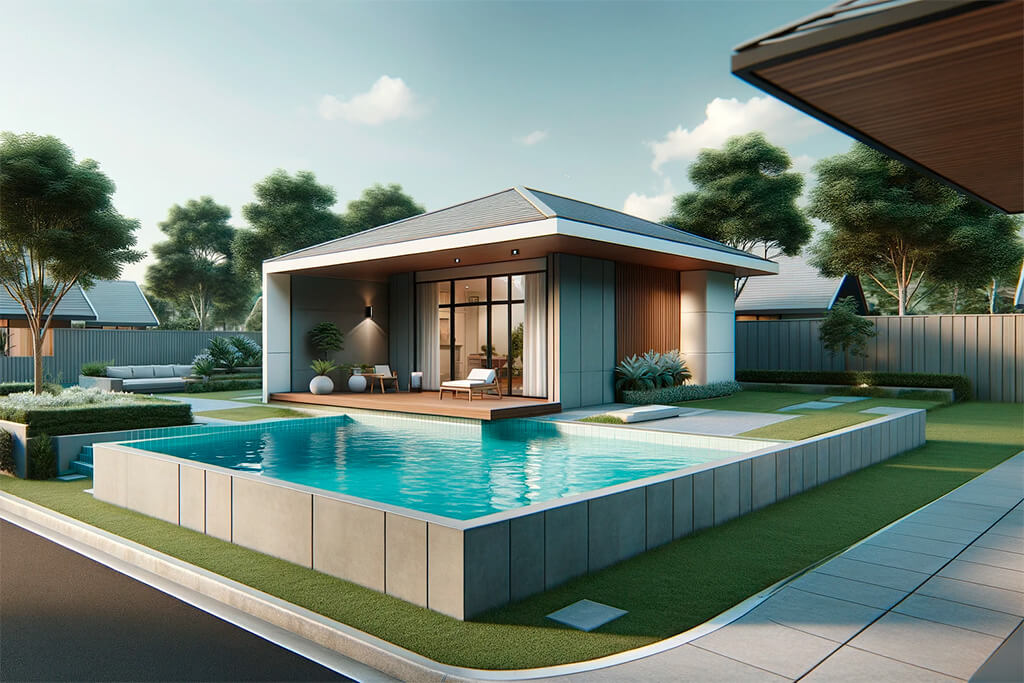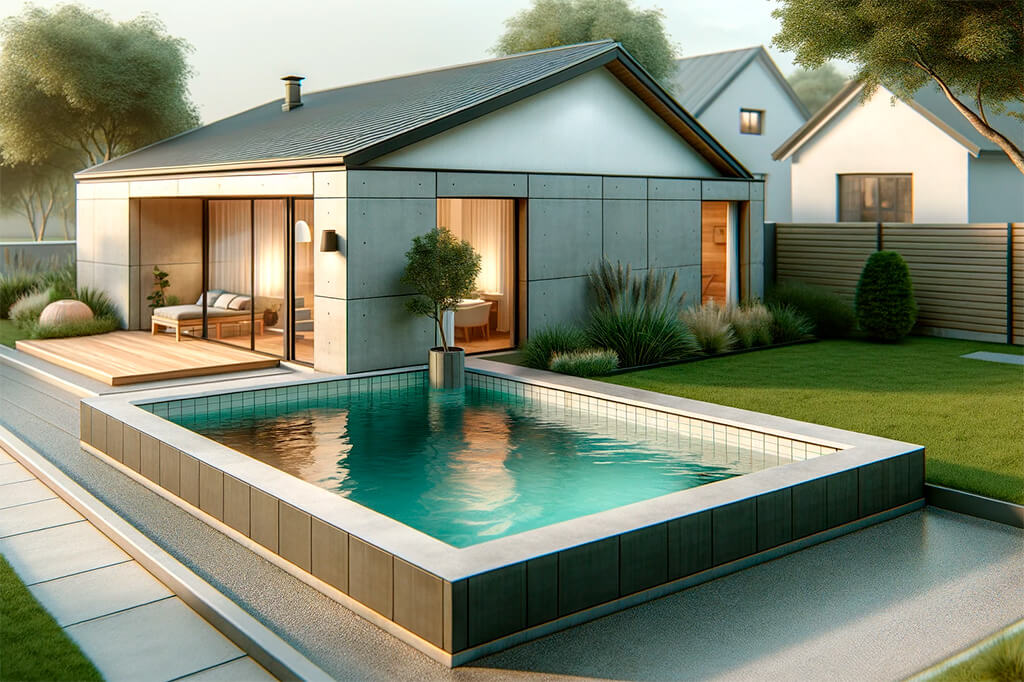The Rise of Plunge Pools: Plunge pools are increasingly becoming a staple in modern homes, particularly for those with limited outdoor space. These compact pools offer a refreshing respite, without the spatial and financial commitments of traditional swimming pools.
Defining Characteristics: A plunge pool is typically compact, usually not extending beyond 10 feet in width and 6 feet in depth. Unlike their larger counterparts, plunge pools are designed more for relaxation and cooling off than for swimming laps.

The Appeal of Plunge Pools
Space Efficiency: Plunge pools are ideal for smaller lots where a traditional pool is not feasible. Their reduced size makes them a practical addition to urban homes.
Cost-Effectiveness: With smaller dimensions come lower costs in materials and construction. This makes plunge pools a more accessible option for homeowners looking to add value to their property without a hefty investment.
Aesthetic Value: These pools can significantly enhance the visual appeal of a backyard. With the right design, they can turn an ordinary space into a tranquil retreat.
Design and Types
Diverse Designs: Plunge pools come in various styles, including inground and above-ground options. Each has its own set of benefits, catering to different preferences and site conditions.
- Inground Pools: These offer a seamless integration into the landscape but require more extensive excavation and construction.
- Above Ground Pools: These are more budget-friendly and quicker to install but might not blend as smoothly with the surrounding environment.
Material Choices:
- Concrete: Offers durability and customization but demands more labor and time.
- Fiberglass: These pre-molded pools are easier and quicker to install but offer less flexibility in terms of shape and size.
Stylistic Considerations: From sleek, modern designs that feature crisp lines and minimalist aesthetics to naturalistic styles that blend with the landscape, the design of a plunge pool can be tailored to complement the home’s architecture and the owner’s personal taste.

Size Matters: Choosing the Right Plunge Pool
Key Considerations:
- Available Space: Assess the space carefully to ensure the pool fits comfortably while allowing room for surrounding elements like decking or landscaping.
- Intended Use: Consider how you plan to use the pool – is it primarily for cooling off, relaxation, or perhaps aquatic exercise?
- Budget: Keep a realistic budget in mind, factoring in not only the construction costs but also long-term maintenance.
Standard Dimensions: While plunge pools generally range in size, a common dimension is about 10×15 feet, with a depth of 4-6 feet. These dimensions can be adjusted based on specific site and user requirements.
Customization Options: For those with specific needs or unique spaces, custom plunge pools are an excellent solution. Though more costly, they offer the flexibility to create a pool that perfectly fits your space and meets your personal requirements.
Installation Insights
Steps involved in installing a plunge pool:
- Site Preparation: The groundwork is critical. Ensure that the selected area is free from obstructions, level, and safe for excavation. It’s imperative to check for underground utilities before digging.
- Excavation: For inground pools, precise excavation is key. Follow the outlined dimensions meticulously to avoid costly adjustments later.
- Framework Setup: Constructing the pool’s framework, be it steel for concrete pools or preparing for a fiberglass shell, demands precision. This step is foundational to the pool’s integrity.
- Plumbing and Electrical Work: This phase involves intricate work and must adhere to local codes. Proper installation of plumbing and electrical systems is vital for the pool’s functionality and safety.
- Concrete Pouring or Fiberglass Placement: Pouring concrete requires skill to ensure an even, smooth surface. If using fiberglass, ensure the shell is placed correctly and securely.
- Finishing Touches: This final phase includes tiling, coping, and decking. This stage not only enhances the pool’s aesthetic but also its durability.
Timeframe and key considerations:
- Installation typically ranges from several weeks to a couple of months. Factors such as weather, complexity of the design, and unforeseen challenges can affect this timeline.
- Patience is crucial. Rushing through stages, particularly concrete curing, can undermine the pool’s quality.
DIY vs. professional installation:
- DIY Approach: This can be cost-effective for those with substantial experience in construction. However, it’s important to realistically assess your skills, tools, and time availability.
- Professional Installation: Often the recommended route, as professionals bring expertise, efficiency, and adherence to safety standards. This option also usually includes warranties and post-installation support.
Maintenance and Upkeep
Routine cleaning and maintenance:
- Skimming and Vacuuming: Regular removal of debris is essential. It prevents clogging and maintains the aesthetic appeal.
- Filter Maintenance: Keeping filters clean ensures efficient circulation and filtration of water.
- Structural Monitoring: Regular inspection for structural integrity can prevent major repairs. Addressing small issues promptly can save time and money.
Water quality:
- Chemical Balance: Maintaining the correct chemical balance is paramount for safe and clean water. Regular testing and adjustments are necessary.
- Shock Treatment: Periodic shock treatments are recommended to eliminate any lingering bacteria or algae.
Seasonal care:
- Winterizing: In colder climates, preparing the pool for winter involves lowering water levels, protecting plumbing, and covering the pool to prevent damage.
- Summer Preparation: As the warm season approaches, a thorough check of all systems, comprehensive cleaning, and chemical rebalancing are essential to ensure the pool is safe and inviting.
In conclusion, while installing and maintaining a plunge pool is a significant undertaking, with proper planning, execution, and regular upkeep, it can be a rewarding addition to your home, offering a private retreat and enhancing your property’s value.
Cost Considerations
Breakdown of Initial Costs:
- Purchase: The cost of a plunge pool varies depending on the type. Fiberglass pools are typically more affordable, whereas concrete pools can be pricier due to their customizable nature.
- Installation: A significant portion of your budget will go towards installation. This includes excavation, plumbing, and electrical work. It’s worth considering that while DIY might reduce costs, professional expertise ensures quality and longevity.
- Landscaping: Finishing touches like decking, plantings, and pathways not only complete the look of your plunge pool but also contribute to the overall cost. Thoughtful landscaping can enhance the pool’s aesthetic and functional appeal.
Long-Term Expenses:
- Maintenance: Regular maintenance is essential for the longevity of the pool. This includes cleaning, chemical balancing, and occasional repairs.
- Utilities: Operating the pool’s pump and heater (if installed) will impact your utility bills. Opting for energy-efficient models can offer long-term savings.
Cost-Saving Tips:
- Comparative Shopping: Researching and comparing prices for materials and labor can lead to significant savings.
- Energy Efficiency: Investing in a high-quality pool cover and energy-efficient equipment can reduce ongoing utility costs.
- DIY When Feasible: Engaging in some DIY for landscaping or routine maintenance can help to manage expenses, provided you have the necessary skills.
FAQ Section
Plunge pools are smaller and shallower than traditional swimming pools, designed primarily for relaxation and cooling off rather than swimming.
The installation time varies depending on the pool type and complexity. Simple fiberglass pools can be installed in a few days, while custom concrete pools may take several weeks.
Yes, plunge pools can be equipped with heating systems for year-round use, though this will affect ongoing utility costs.
Permit and zoning requirements vary by location. It’s crucial to check with local authorities to ensure compliance with regulations and avoid potential fines.
